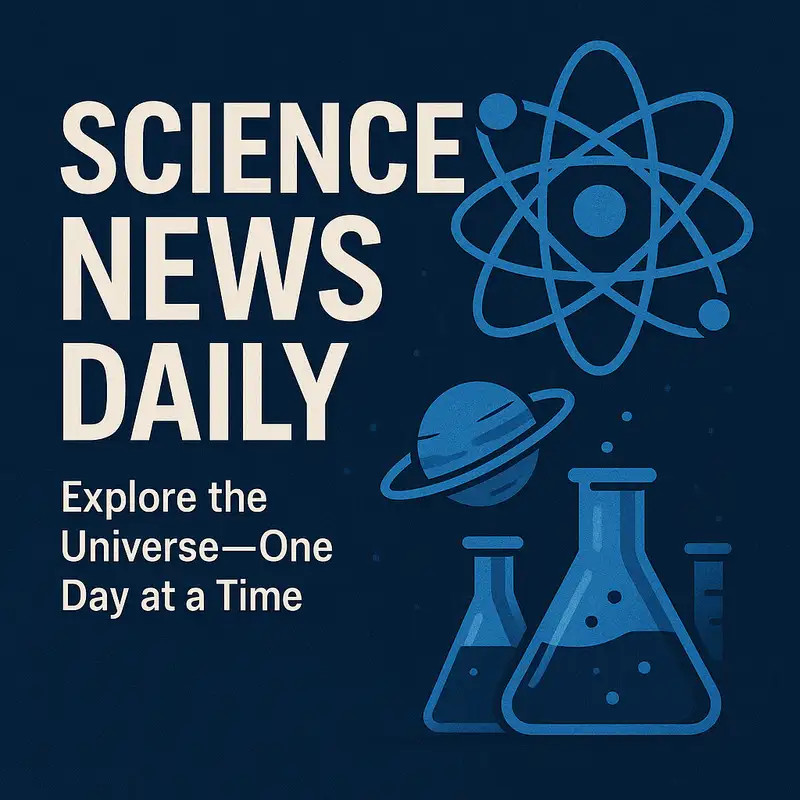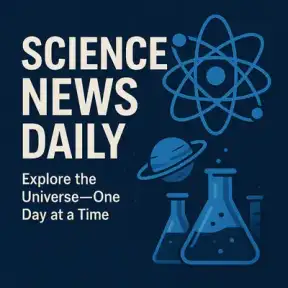🔬 Scientists Just Discovered How to Listen to Dark Matter's Ancient Whispers
Welcome to Science News Daily, where we explore the most fascinating discoveries from around the world. I'm your host, and today we're diving into some truly extraordinary findings that are reshaping our understanding of the universe, life, and everything in between.
Let's start our journey in the deepest reaches of space and time. Scientists have made a remarkable breakthrough that could finally help us understand one of the universe's greatest mysteries: dark matter. Using sophisticated simulations, researchers have discovered that faint radio signals from the cosmic Dark Ages - that period before the first stars ever formed - might hold the key to exposing dark matter's true nature. These ghostly radio whispers from ancient hydrogen are nearly impossible to detect from Earth, but future Moon missions could change everything. The Moon's radio-quiet environment, shielded from Earth's electromagnetic interference, could provide the perfect observatory for capturing these primordial signals. It's like trying to hear a whisper in a crowded room, but from the Moon, we might finally have the silence we need to listen to the universe's earliest secrets.
Speaking of cosmic mysteries, astronomers have just solved a black hole puzzle that's been stumped scientists for a century. Using cutting-edge simulations, researchers studying the supermassive black hole M87 star - a monster six and a half billion times the mass of our Sun - have uncovered how these cosmic behemoths unleash their incredible power. It turns out it's not just magnetic fields at work, but a process called magnetic reconnection that helps extract energy from these gravitational giants. This discovery is rewriting our understanding of how black holes shape the universe around them.
Now, let's shift our focus closer to home and explore some fascinating insights about how our brains might work. Scientists at Skoltech have developed a revolutionary mathematical model of memory that suggests something surprising: our brains might actually work best with seven senses, not the traditional five we learned about in school. Their analysis indicates that memory functions optimally in a seven-dimensional conceptual space, which could explain why both humans and artificial intelligence might benefit from broader sensory inputs to enhance learning and recall. This finding opens up intriguing possibilities for improving both human cognition and AI development.
Here's some great news for fitness enthusiasts. Australian researchers have just debunked a long-standing exercise myth that's been discouraging people for years. You know that old saying about exercise using up your limited supply of heartbeats? Well, it turns out that's completely backwards. The groundbreaking study reveals that fitter individuals actually use fewer heartbeats each day than their sedentary counterparts. So rather than draining your heart's battery, exercise is actually helping it work more efficiently. It's another powerful reminder that physical activity truly is medicine for our bodies.
In the realm of medical breakthroughs, researchers have made a potentially game-changing discovery in the fight against Parkinson's disease. Scientists have designed a peptide that prevents the deadly misfolding of alpha-synuclein, the protein responsible for Parkinson's and some forms of dementia. In laboratory and animal tests, this molecular intervention stabilized the protein and improved motor function. This work demonstrates the incredible power of rational drug design in tackling brain diseases that have long lacked effective treatments. For millions of people affected by these conditions, this research offers genuine hope for the future.
And speaking of staying healthy as we age, researchers at the University of Basel have uncovered something remarkable about certain nutrients in food. They've discovered food molecules that can actually trick cells into staying young. These nutrients cause a mild stress reaction that, surprisingly, boosts overall health and helps organisms maintain vitality as they age. It's a perfect example of how sometimes a little stress can be a good thing - what doesn't kill you really might make you stronger, at least at the cellular level.
Let's take a moment to appreciate the incredible world of insects. Scientists have finally uncovered the secret behind ants' extraordinary sense of smell, which is crucial for building and organizing their complex societies. Each ant neuron can detect only one specific scent, keeping their chemical messages crystal clear. Researchers studying clonal raider ants discovered that each neuron activates one odor gene while silencing all others. It's an elegant solution to the challenge of chemical communication that puts even our most sophisticated technologies to shame.
From ants to bees, the insect world continues to amaze us. Researchers have found that pollen collected by honeybees is packed with beneficial bacteria that produce natural antibiotics. These microbes defend bees from harmful diseases, essentially turning their pollen stores into a microbial shield. The bees unknowingly bring these protective bacteria home from flowers, creating their own pharmaceutical factory. It's yet another reminder of nature's incredible ingenuity.
However, not all our science news today is celebratory. New research reveals a concerning threat to deep-sea ecosystems. The rise of deep-sea mining could erase sharks we've only just discovered. Scientists have identified thirty species of sharks, rays, and ghostly chimaeras that inhabit regions targeted for mineral extraction on the seafloor. Many of these species are already endangered, and the disruption of their delicate habitats could push some toward extinction before we even fully understand them.
On a lighter note, let's travel back in time to solve an ancient mystery. Scientists have finally proven that the famous moai statues of Easter Island could indeed walk. Using experiments with replicas and 3D models, researchers confirmed that these massive statues could move upright using a rocking motion, aided by rope and just a few people. Design features like a forward lean and curved bases made this movement possible, and concave roads across the island further supported this transport method. It's a beautiful celebration of the innovation and intelligence of ancient islanders.
Our cosmic discoveries continue with the James Webb Space Telescope, which may have found something extraordinary: the universe's first dark stars. These aren't your typical stars powered by nuclear fusion, but potentially something entirely new - stars powered by dark matter itself. These observations from within the first few hundred million years after the Big Bang could revolutionize our understanding of how the earliest stars formed.
Finally, the Webb telescope has also captured the final moments of a doomed star cloaked in dust. For the first time, astronomers have identified a massive red supergiant star before it exploded, revealing that many of these stellar giants are hidden behind thick clouds of cosmic dust. This discovery is helping us understand the final stages of stellar evolution in unprecedented detail.
That wraps up today's journey through the latest in scientific discovery. From the cosmic Dark Ages to the smallest cellular mechanisms, from ancient Easter Island mysteries to cutting-edge space telescopes, science continues to reveal the incredible complexity and beauty of our universe. Keep looking up, keep asking questions, and remember that every day brings new wonders to explore. I'm your host, and this has been Science News Daily. Until next time, stay curious.

